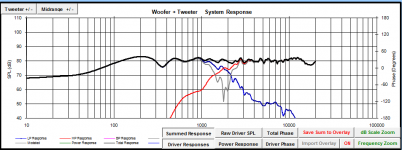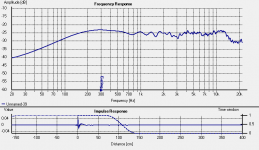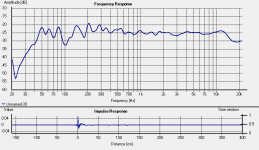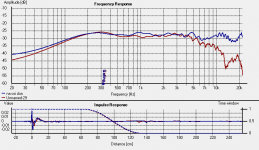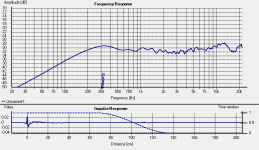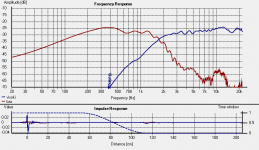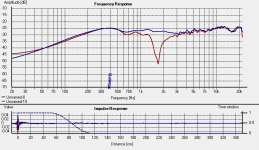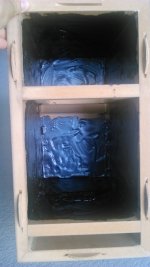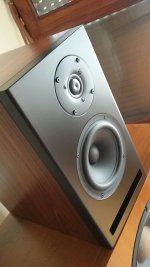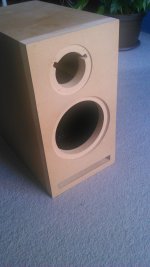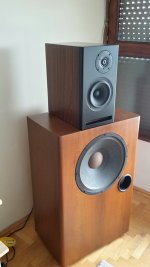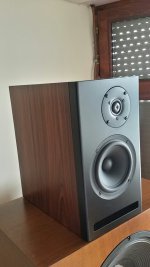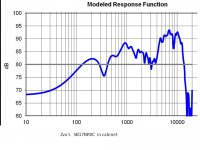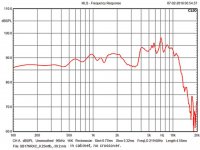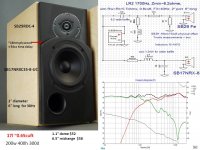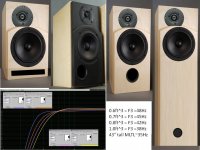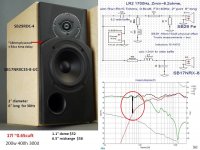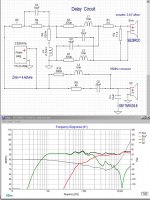I made some measurements and derived the .frd and .zma files for this particular drivers. I've been playing for a while with different types of xovers. Files are attached so anyone who wishes can play with it in PCD by Jeff Bagby, WinPCD or Boxsim and see if the drivers suits him.
If anyone shows interest for it, i can upload the files from Holm-Impulse if you want to change the gate and derive your own files.
The mic is on tweeter axis, about 1.2m distance.
cheers
If anyone shows interest for it, i can upload the files from Holm-Impulse if you want to change the gate and derive your own files.
The mic is on tweeter axis, about 1.2m distance.
cheers
Attachments
Last edited:
Thanks Mordikai, i think so too.
@Mayhem - i have yet to try this xover, it is 18dB/o-12dB/o electrical. In a few days i'll have all parts for it so i'll give it a try. I modeled few variants with 4th order electrical at 1.5KHz xover and different levels of compensation.
Working with this tweeter is a treat. Midwoofer can be challenging depending on what you want to do with it. Breakup can be hard to handle depending on the level of refinement you want to achieve.
I haven't measured nearfield and have not merge the responses because gate is at about 250Hz, and baffle step occurs at 550Hz so i matched FR level with 400Hz. Measurements are in the real cabinets so one can see what he can expect from it regarding baffle step, difraction etc.
@Mayhem - i have yet to try this xover, it is 18dB/o-12dB/o electrical. In a few days i'll have all parts for it so i'll give it a try. I modeled few variants with 4th order electrical at 1.5KHz xover and different levels of compensation.
Working with this tweeter is a treat. Midwoofer can be challenging depending on what you want to do with it. Breakup can be hard to handle depending on the level of refinement you want to achieve.
I haven't measured nearfield and have not merge the responses because gate is at about 250Hz, and baffle step occurs at 550Hz so i matched FR level with 400Hz. Measurements are in the real cabinets so one can see what he can expect from it regarding baffle step, difraction etc.
Last edited:
As there is a chance for this to become comercial design, xover schematic is not shown. But i uploaded the files for people to play with and make their own. I made gate a little too much because i like to see what can i do with it but i offered to upload the measurements so people can set the gate that suits them and derive frd.
I do not follow you on "off setting the tweeter". If you are talking about differences between sim and measurements - that is because of gate set a bit too much. If you are reffering to tweeter horizontal offset on the front baffle, it is to deal with diffraction.
Cheers
I do not follow you on "off setting the tweeter". If you are talking about differences between sim and measurements - that is because of gate set a bit too much. If you are reffering to tweeter horizontal offset on the front baffle, it is to deal with diffraction.
Cheers
Last edited:
Thnk you very much for the frd and zma files!
Now I can finally complete my (2) designs.
Attached SPL Plots for:
-Zvu’s SB17NRXC in cabinet no crossover
-Troel's SB17NRXC in cabinet no crossover (from his website)
Same 5db/major_tick. It's nice to have comparison data you can use for your designs.
=======
If you have studied Troel's website you understand his opinion on "sonic differences" from TM crossovers designed to address the issue of time-alignment.
There are several engineering ways to "overcome" the problem:
Troels:
#1. Use an asymmetrical crossover usually consisting of 2nd order to the bass and 3rd order to the tweeter to make "proper" phase integration.
#2. Use 4th order filters to both drivers, e.g. LR4, and due to the large phase shift, the lack of alignment is negligible - although I really feel it isn't.
#3. Tilt the front panel so that with a listening height somewhere between the bass and tweeter we more or less compensate for the time difference.
#4. Place the tweeter below the midbass. Having the midbass at ear height, the tweeter will - to some extent - be better aligned with the midbass driver.
#5. Use an all-pass filter to delay tweeter response.
#6. Ignore the problem and implement a simple 2nd order filter which produces a decent linear frequency response.
Attachments
Thanks for the comments LineSource.
About 5dB difference, when i made frd files for midwoofer and tweeter i make it by default 5dB less to be able to derive the Z offset in Jeff Bagby PCD. I'm used to working with high sensitivity loudspeakers and too often summed response goes out of the graph. When i set it that the whole graph is visible, resolution gets pretty bad because the grid gets 20dB.
That is one of the reasons i offered to upload HOLMimpulse files so you can set the gate and derive the frd for yourself.
What is important - relative responses are propper between midwoofer and tweeter and allows for precise xover design. The sensitivity will be greater by 5dB. I just didn't mention it on the first post.
As for the xover, it is asymetrical. I don't like the diffraction of stepped baffle and tilted is out of the question because of ring radiator directivity.
Cheers
About 5dB difference, when i made frd files for midwoofer and tweeter i make it by default 5dB less to be able to derive the Z offset in Jeff Bagby PCD. I'm used to working with high sensitivity loudspeakers and too often summed response goes out of the graph. When i set it that the whole graph is visible, resolution gets pretty bad because the grid gets 20dB.
That is one of the reasons i offered to upload HOLMimpulse files so you can set the gate and derive the frd for yourself.
What is important - relative responses are propper between midwoofer and tweeter and allows for precise xover design. The sensitivity will be greater by 5dB. I just didn't mention it on the first post.
As for the xover, it is asymetrical. I don't like the diffraction of stepped baffle and tilted is out of the question because of ring radiator directivity.
Cheers
Last edited:
As for your xover model - i tried something like that but i gave up because measured Fs of SB29RCD is arround 620Hz. Your xover model is arround -15dB or -17dB at Fs of the tweeter. I'm affraid it would strain the tweeter if listened in larger rooms.
Attachments
Last edited:
Those cabinets look very clean!
Two questions though:
Have you used the same placement of the speakers as Bagby's Mandolin?
Why did you go for a bandpass design (with the sub)?
I'm very interested in your inbox measurements.
I have found some different measurements as well:
SB17NRXC35-8 by Udo Wohlgemuth (Intertechnik sb18):
https://www.lautsprecherbau.de/design/stories/Artikel/2008/Dezember/SB18/SB17NRXC35.zip
SB17nrxc35-8 by David Ralph:
http://www.speakerdesign.net/raw/zip/raw_sb17rnx35-8.zip
The measurement by Udo was almost identical to my SPL trace of Zaph's measurements.
Two questions though:
Have you used the same placement of the speakers as Bagby's Mandolin?
Why did you go for a bandpass design (with the sub)?
I'm very interested in your inbox measurements.
I have found some different measurements as well:
SB17NRXC35-8 by Udo Wohlgemuth (Intertechnik sb18):
https://www.lautsprecherbau.de/design/stories/Artikel/2008/Dezember/SB18/SB17NRXC35.zip
SB17nrxc35-8 by David Ralph:
http://www.speakerdesign.net/raw/zip/raw_sb17rnx35-8.zip
The measurement by Udo was almost identical to my SPL trace of Zaph's measurements.
Those cabinets look very clean!
Two questions though:
Have you used the same placement of the speakers as Bagby's Mandolin?
Why did you go for a bandpass design (with the sub)?
I have. I didn't do a bandpass. Respectively
15" serves as a loudspeaker stand for the time being - untill it's moved to another system.
I'm very interested in your inbox measurements.
The frd files from the first post are raw measurements inside speaker cabinets.
I have found some different measurements as well:
SB17NRXC35-8 by Udo Wohlgemuth (Intertechnik sb18):
https://www.lautsprecherbau.de/design/stories/Artikel/2008/Dezember/SB18/SB17NRXC35.zip
SB17nrxc35-8 by David Ralph:
http://www.speakerdesign.net/raw/zip/raw_sb17rnx35-8.zip
The measurement by Udo was almost identical to my SPL trace of Zaph's measurements.
This is raw inbox measurement done by Udo:

And this is raw inbox measurement done by David Ralph:
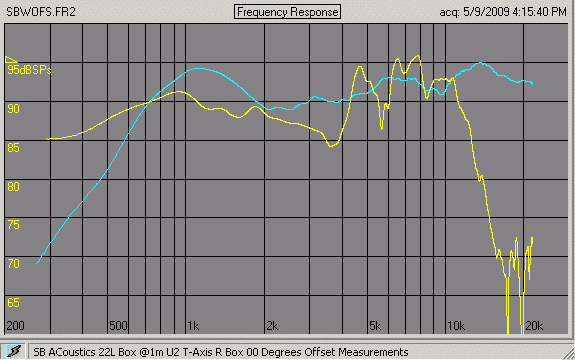
Approximately +7dB at 1KHz in regard to 3.5KHz dip. I'd say my measurements are spot on - but with a little longer gate than it should be. Logic behind it is that if i make it work in the sim and it is flat enough, measurements with right amount of gate will be better and flatter - as shown in posts No 5 and 6
The only measurement that is different is Troels measurement and he made stepped baffle that has different diffracion pattern. That's all.
The thing i didn't post here is merged midwoofer raw inbox response to show for quasi anechoic measurements to 20-30Hz.
The sound is as good as it measures - smooth, lively, unobtrusive and above all natural.
Cheers
Last edited:
Sorry, I meant vented box.
You're right, the measurements of all parties resemble each other.
Good luck!
I made bass reflex cabinets because SB17NRXC35 by TS parameters favours it.
Factory provided TS parameters are not entirely correct. I measured TS - i can upload them when i get back from work.
Does anyone have experience with using a passive component all-pass filter to delay the tweeter response on a flat baffle?? Measurements and listening tests?
Attached a paper design for crossover with an all-pass filter to delay tweeter response and reduce phase shift. Troels in-box SPL measurements.
----------
Troels: There are several engineering ways to "overcome" the Mid-Tweet time-alignment problem:
#1. Machine a 2-height stepped baffle which physically time-aligns the tweeter to the midrange at the LR2/LR2 crossover frequency.
#2. Use an asymmetrical crossover usually consisting of 2nd order to the bass and 3rd order to the tweeter to make "proper" phase integration.
#3. Use 4th order filters to both drivers, e.g. LR4, and due to the large phase shift, the lack of alignment is negligible - although I really feel it isn't.
#4. Tilt the front panel so that with a listening height somewhere between the bass and tweeter we more or less compensate for the time difference.
#5. Place the tweeter below the midbass. Having the midbass at ear height, the tweeter will - to some extent - be better aligned with the midbass driver.
#6. Use an all-pass filter to delay tweeter response.
#7. Ignore the problem and implement a simple 2nd order filter which produces a decent linear frequency response.
Attached a paper design for crossover with an all-pass filter to delay tweeter response and reduce phase shift. Troels in-box SPL measurements.
----------
Troels: There are several engineering ways to "overcome" the Mid-Tweet time-alignment problem:
#1. Machine a 2-height stepped baffle which physically time-aligns the tweeter to the midrange at the LR2/LR2 crossover frequency.
#2. Use an asymmetrical crossover usually consisting of 2nd order to the bass and 3rd order to the tweeter to make "proper" phase integration.
#3. Use 4th order filters to both drivers, e.g. LR4, and due to the large phase shift, the lack of alignment is negligible - although I really feel it isn't.
#4. Tilt the front panel so that with a listening height somewhere between the bass and tweeter we more or less compensate for the time difference.
#5. Place the tweeter below the midbass. Having the midbass at ear height, the tweeter will - to some extent - be better aligned with the midbass driver.
#6. Use an all-pass filter to delay tweeter response.
#7. Ignore the problem and implement a simple 2nd order filter which produces a decent linear frequency response.
Attachments
- Status
- This old topic is closed. If you want to reopen this topic, contact a moderator using the "Report Post" button.
- Home
- Loudspeakers
- Multi-Way
- SB17NRXC35-8 and SB29RDC-C0004 playground
